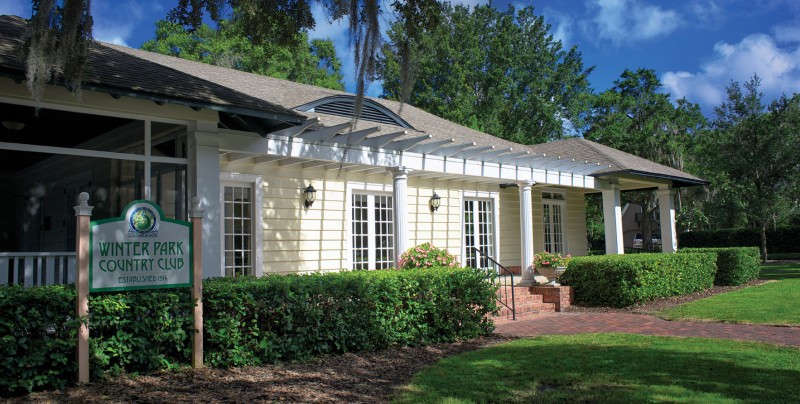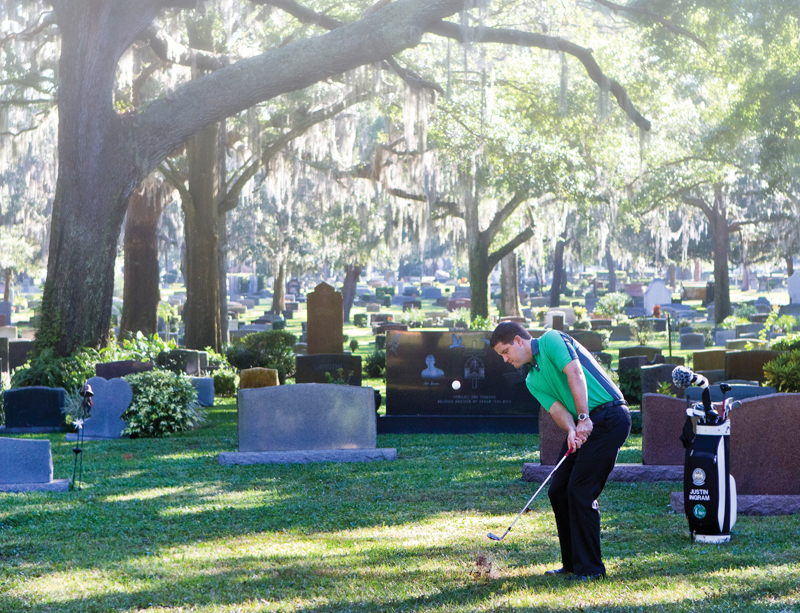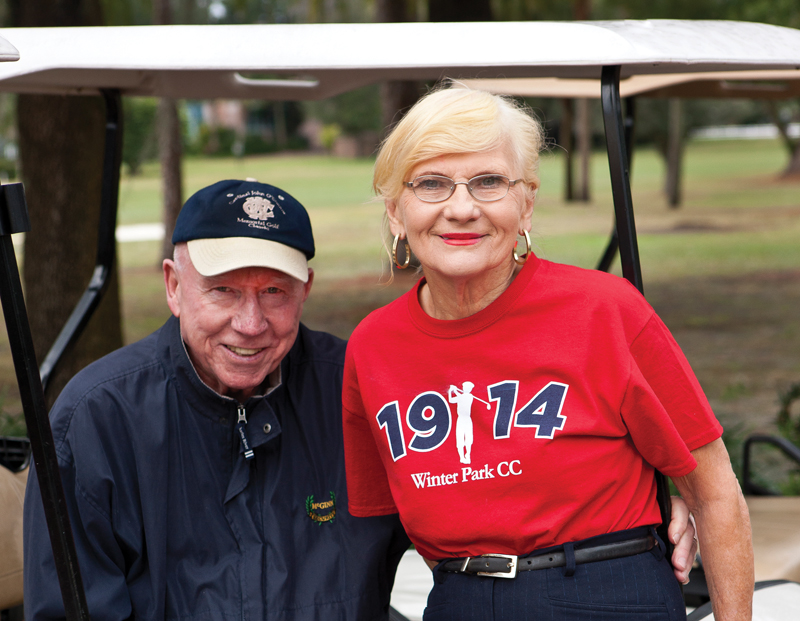
THE CENTURY-OLD WINTER PARK COUNTRY CLUB SOUNDS EXCLUSIVE, BUT IT’S ACTUALLY HOMEY AND WELCOMING. IN FACT, IT ISN’T EVEN REALLY A CLUB.
Shall we meet for a round of golf at the Winter Park Country Club?” The question certainly has a snooty tone. After all, any country club located in a place like Winter Park simply has to be a plutocrat’s paradise, excluding riffraff and commanding dues that are more than most people earn in year.
Right? Actually, wrong.
It’s much more difficult to get into The Coop at lunchtime than it is to get into the Winter Park Country Club. In fact, to play a round at “Winter Park National,” as pro golfer and Winter Park resident Nick Faldo once dubbed the nine-hole layout, all you have to do is show up.
And to join the Winter Park Country Club? Well, if you’re a Winter Park taxpayer, riffraff or not, you’re already a member and a part owner of the quirky course and the modest, Florida Cracker-style buildings that serve as its clubhouse and pro shop.
The entire complex has been owned and operated by the city — and subsidized by your tax dollars — since 1996. But the history of the city’s signature course goes back much further than that.
Last September, the Winter Park Country Club celebrated its 100th anniversary with the unveiling of a new centennial clock adjacent to the putting green.
The clock was donated by the Elizabeth Morse Genius Foundation, which was appropriate since city benefactor Charles Hosmer Morse, Elizabeth’s father, was one of the original organizers — the driving force, if you will — behind founding the club and constructing the course.
At ceremonies unveiling the clock, Florida Secretary of State Ken Dantzler and Florida State Historic Preservation Officer Robert F. Bendus joined local dignitaries in announcing formation of the Florida Historic Golf Trail, a collection of the state’s 51 oldest courses.
The venerable courses, all of which are still publicly accessible, will be promoted in nationally broadcast television commercials featuring golf legend Arnold Palmer, who touts the trail initiative and salutes Florida’s golfing heritage.
Despite having reached the century mark, the Winter Park Country Club’s course, which is bisected by Park Avenue North, is actually only the second-oldest course in the Orlando area. The Country Club of Orlando’s layout opened for play one year earlier.
Nonetheless, kickoff festivities for the trail program were held in Winter Park and broadcast on the Golf Channel’s Morning Drive program. It was an unaccustomed turn in the spotlight for the club, which is typically a low-key — but quietly indispensable — community asset.
Generations of Winter Parkers grew up learning the game on the par-35 course, where duffers who hit errant shots must sometimes play around tombstones in Palm Cemetery, the border of which lies about 20 yards off the No. 4 green. Appropriately, many of the club’s founders are interred there.
“This course is a gem for the city,” says Barbara Breen, a four-time women’s champion in club competition. “We have a group of women who play regularly. I think the youngest is in her 50s and the oldest is 91.”
Giants have also strode these hoary greens. In addition to Faldo, golfing greats such as Ben Hogan, Sam Snead, Gene Sarazen and Walter Hagen have played the course, sometimes in exhibition matches.
Modern-day pros such as Billy Horschel, Chris DiMarco and Michelle McGann, a seven-time winner on the LPGA tour, have also complimented the course’s lovely setting and distinctive personality.
′ ′ ′
As far back as 1899, Winter Parkers had a place to play golf. The so-called “Rollins 9” was a nine-hole course commissioned by Morse that encompassed the west side of the Rollins College campus and part of what’s now downtown Winter Park.
But in 1914, Morse and others decided that a proper country club was needed. The Winter Park Country Club, a nonprofit corporation, was established and a nine-hole course was designed by Harley A. Ward and Dow George, who became the club pro.
The course, and the $3,500 clubhouse, was built on property owned by Morse, who was also elected first president of the nascent organization.
Another 18 holes were added the following year. Although the 27 holes were considered two separate courses, they shared the first fairway and green, and extended all the way to U.S. 17-92, where Winter Park Village now sprawls.
Play was sometime interrupted by stray cows, prompting club officials to erect a fence. Some livestock, including sheep and goats, were welcomed, though. The unwitting animals kept the grass in check and were later slaughtered to help alleviate a meat shortage during World War I.
A decade later, the club’s heyday had seemingly come to a close. The much more posh Aloma Country Club, which encompassed the present-day location of Ward Park and Winter Park Memorial Hospital, opened in 1926 and lured players away. Aloma’s 6,180-yard course and $45,000 clubhouse made the relatively modest Winter Park Country Club obsolete, forcing it to close shortly thereafter.
The block bounded by Interlachen, Webster and Park avenues was bought by the city and repurposed as Charles H. Morse Memorial Park (the philanthropist had died in 1921). The clubhouse remained, and was occupied for a time by the newly formed University Club of Winter Park. The rest of the land was, thankfully, never developed.
But Winter Park Golf Estates, the real-estate development surrounding the Aloma course, ultimately failed, and the course itself was abandoned in 1936, a casualty of the Great Depression.
′ ′ ′

Led by the Winter Park Chamber of Commerce, local movers and shakers decided to reactivate the dormant Winter Park Country Club and raise funds to rehabilitate the older course. Donations amounted to $6,250, which was more than enough to do the job.
When the complex reopened in 1937, the annual membership fee was $44 and greens fees were $1. Jones, who had been snapped up by the ill-fated Aloma Country Club, was rehired as club pro, a position he would hold until his retirement in 1964.
The new incarnation of the club leased the property, partially from the city but primarily from the Winter Park Land Company, which had been formed by Morse in 1915 when he acquired the vast land holdings of its defunct predecessor, the Winter Park Company.
Later, the Winter Park Land Company’s portion of the property, totaling about 25 acres, was transferred to the Charles Hosmer Morse and Elizabeth Morse Genius foundations, which continued to lease it to the city in 10-year increments.
As long as the land was owned by the foundation and leased to the club, there was no guarantee that this prime piece of real estate would forever remain green space. In fact, as an extension of the lease was being discussed in 1996, foundation officials expressed an interest in selling the land to developers.
City leaders and residents weren’t about to let that happen. In a lively referendum, voters overwhelmingly approved a proposal to raise taxes and buy the course. The $8 million purchase price was backed by a 20-year, $5.1 million bond issue. In 2016, the bonds will have been repaid in full.
′ ′ ′
The course and the structures, which fall under the umbrella of the city’s Parks & Recreation Department, cost about $600,000 per year to operate. Although the annual deficit usually tops $85,000, it’s hard to find anyone these days who’ll say the taxpayers made a bad investment.
The 2,470-yard layout hosts about 30,000 rounds of golf per year, about 3,200 of which are played by kids 16 and under. Players pony up between $12 and $14 per round, depending on the time of day and time of year.
An annual individual membership costs a whopping $600. Rates are slightly higher for non-residents. But the word “membership” is a misnomer. In fact, the course is a public facility, and so-called memberships are simply prepaid rounds of golf.
“I guess we could charge more, but right now this course is one of the best values in golf,” says Justin Ingram, general manager and club pro. Ingram grew up in Winter Park and played the course as a child. “It’s accessible to everybody, from every walk of life.”
The lovingly maintained but entirely unpretentious clubhouse, with its working fireplace and oak floors, is often busy hosting functions. The clubhouse and the course were listed on the National Register of Historic Places in 1999.
The adjacent pro shop was renovated in 2011. Visitors can see exposed wood on the interior walls salvaged from a 1914 starter shack and from a previous remodeling effort in 1967. Merchandise is modestly priced, considering the upscale connotations of the Winter Park brand.
Casa Feliz, a restored Spanish-style farmhouse that was saved from the wrecking ball following an uprising of irate citizens, was moved to a patch of unused city property adjacent to the 9th hole in 2001 and repurposed as a community building. The historic home’s stately presence only adds to the course’s irresistible charm.
′ ′ ′

Most players — many of whom are regulars — are quick to point out that while the course may be historic, it’s no museum piece. Breen, whose husband Larry is also an avid golfer, says the layout “is more challenging than people who drive by it probably realize.”
Indeed, the fairways are narrow and the greens are small, meaning your short game had better be sharp. But even if it isn’t, who could possibly get frustrated in a setting like this?
Not Danny Stanley, who operates a trucking and logistics business from his home. He plays virtually every day, and enjoys the course’s walkability and the eclectic cross-section of patrons that he encounters along the way.
“About 10:30, I start to get anxious to get out,” says Stanley, who first played the course in the late 1950s. “So I go up and play a round, which takes about two hours, then maybe walk up to Park Avenue and have lunch with a group of guys. It’s just the perfect setting.”
Groucho Marx once famously said that he would never join a club that would have him for a member. But after spending a morning with Stanley, even Groucho might change his mind.

